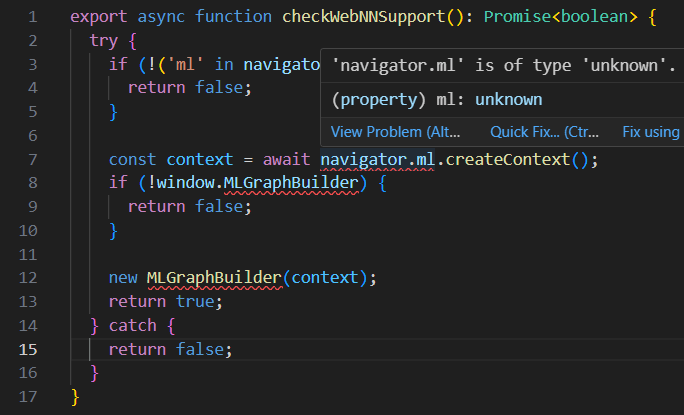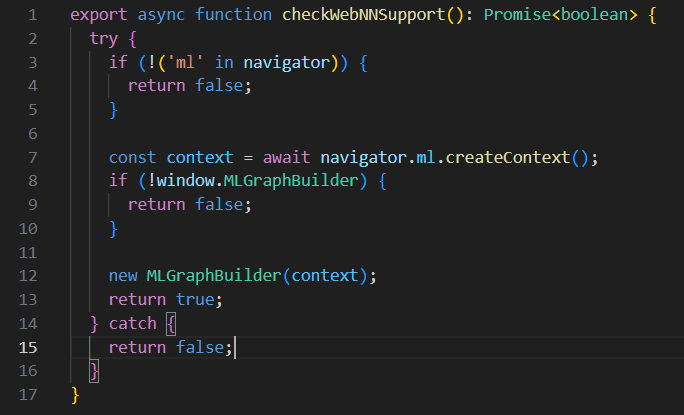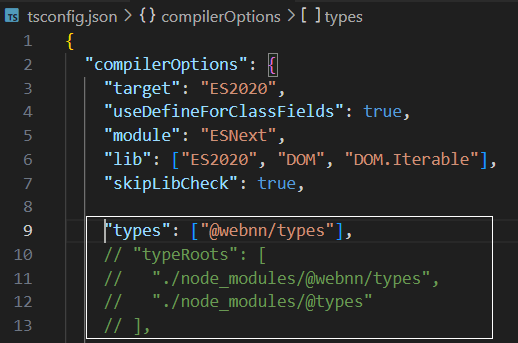Using TypeScript with WebNN API
TypeScript (TS) provides strong typing capabilities for JavaScript projects, enhancing developer productivity with features like code completion and compile-time error checking. This guide explains how to integrate TypeScript type definitions for the WebNN API in your projects.
Overview
The @webnn/types package contains TypeScript declaration files (.d.ts) for the WebNN API, providing type information for methods, properties, and return values used in the WebNN specification.
Note: You don’t need to use
@webnn/typesif you’re working with JavaScript ML libraries like Transformers.js or ONNX Runtime Web , which includes their own type definitions.
Why Use Type Definitions?
Without type definitions, TypeScript will treat WebNN API objects and methods as having unknown type:

With proper type definitions, TypeScript can provide code completion, parameter validation, and type checking:

Installation
Install the type definitions as a development dependency using your preferred package manager:
# npm
npm install --save-dev @webnn/types
# yarn
yarn add --dev @webnn/types
# pnpm
pnpm add -D @webnn/typesConfiguration
Since @webnn/types is outside of DefinitelyTyped (@types) , you need to explicitly configure TypeScript to recognize these types. You have two options:
Option 1: Using types in tsconfig.json
{
"compilerOptions": {
"types": ["@webnn/types"]
}
}Option 2: Using typeRoots in tsconfig.json
{
"compilerOptions": {
"typeRoots": [
"./node_modules/@webnn/types",
"./node_modules/@types"
]
}
}
Global Types
Once configured, the WebNN types are globally available in your project. You don’t need to import them explicitly - TypeScript will automatically recognize WebNN interfaces like navigator.ml and MLGraphBuilder.
// No need to import WebNN types - they're globally available
async function runInference() {
// TypeScript will recognize these types
const ml:ML = navigator.ml;
const context:MLContext = navigator.ml.createContext();
const builder:MLGraphBuilder = new MLGraphBuilder(context);
const input:MLOperand = builder.input('input', {dataType: 'float32', shape: [1, 3, 224, 224]});
const weights:MLOperand = builder.constant({dataType: 'float32', shape: [16, 3, 3, 3]}, new Float32Array(432));
// Types for convolution parameters
const options:MLConv2dOptions = {
padding: [1, 1, 1, 1],
strides: [1, 1],
dilations: [1, 1],
groups: 1
};
const conv:MLOperand = builder.conv2d(input, weights, options);
const graph:MLGraph = await builder.build({output: conv});
// Rest of the inference code...
}TypeScript Vanilla Example
For a complete working example, refer to the WebNN TypeScript Vanilla Example repository, which demonstrates:
Tips for WebNN TS Development
- Use TypeScript’s autocompletion to discover available methods and properties
- Leverage parameter type checking to avoid common WebNN API usage errors
- TypeScript interfaces will help you conform to the expected shapes of WebNN options objects
- VSCode and other modern editors will show documentation tooltips for WebNN API methods when properly typed